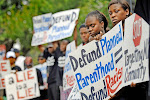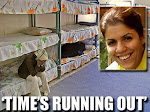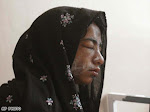 NEW YORK-Six-year-old Oscar Jimenez Jr. was beaten to death in California, then buried under fertilizer and cement. Two-year-old Devon Shackleford was drowned in an Arizona swimming pool. Jayden Cangro, also 2, died after being thrown across a room in Utah.In each case, as in many others every year, the alleged or convicted perpetrator had been the boyfriend of the child's mother-men thrust into father-like roles which they tragically failed to embrace.
NEW YORK-Six-year-old Oscar Jimenez Jr. was beaten to death in California, then buried under fertilizer and cement. Two-year-old Devon Shackleford was drowned in an Arizona swimming pool. Jayden Cangro, also 2, died after being thrown across a room in Utah.In each case, as in many others every year, the alleged or convicted perpetrator had been the boyfriend of the child's mother-men thrust into father-like roles which they tragically failed to embrace.Every case is different, every family is different. Some single mothers bring men into their lives who lovingly help raise children when the biological father is gone for good.Nonetheless, many scholars and front-line caseworkers interviewed by The Associated Press see the abusive-boyfriend syndrome as part of a broader trend that deeply worries them. They note an ever-increasing share of America's children grow up in homes without both biological parents, and say the risk of child abuse is markedly higher in the nontraditional family structures."This is the dark underbelly of cohabitation," said Brad Wilcox, a sociology professor at the University of Virginia. "Cohabitation has become quite common, and most people think, 'What's the harm?' The harm is we're increasing a pattern of relationships that's not good for children."The existing data on child abuse in America is patchwork, making it difficult to track national trends with precision. The most recent federal survey on child maltreatment tallies nearly 900,000 abuse incidents reported to state agencies in 2005, but it does not delve into how rates of abuse correlate with parents' marital status or the makeup of a child's household.Similarly, data on the roughly 1,500 child-abuse fatalities that occur annually in the United States leaves unanswered questions. Many of those deaths result from parental neglect, rather than overt physical abuse. Of the 500 or so deaths caused by physical abuse, the federal statistics do not specify how many were caused by a stepparent or unmarried partner of the parent.However, there are many other studies that, taken together, reinforce the concerns. Among the findings:
_Children living in households with unrelated adults are nearly 50 times as likely to die of inflicted injuries as children living with two biological parents, according to a study of Missouri abuse reports published in the journal of the American Academy of Pediatrics in 2005.
_Children living in stepfamilies or with single parents are at higher risk of physical or sexual assault than children living with two biological or adoptive parents, according to several studies co-authored by David Finkelhor, director of the University of New Hampshire's Crimes Against Children Research Center.
_Girls whose parents divorce are at significantly higher risk of sexual assault, whether they live with their mother or their father, according to research by Robin Wilson, a family law professor at Washington and Lee University.
"All the emphasis on family autonomy and privacy shields the families from investigators, so we don't respond until it's too late," Wilson said. "I hate the fact that something dangerous for children doesn't get responded to because we're afraid of judging someone's lifestyle."Census data leaves no doubt that family patterns have changed dramatically in recent decades as cohabitation and single-parenthood became common. Thirty years ago, nearly 80 percent of America's children lived with both parents. Now, only two-thirds of them do. Of all families with children, nearly 29 percent are now one-parent families, up from 17 percent in 1977.The net result is a sharp increase in households with a potential for instability, and the likelihood that adults and children will reside in them who have no biological tie to each other."I've seen many cases of physical and sexual abuse that come up with boyfriends, stepparents," said Eliana Gil, clinical director for the national abuse-prevention group Childhelp."It comes down to the fact they don't have a relationship established with these kids," she said. "Their primary interest is really the adult partner, and they may find themselves more irritated when there's a problem with the children."
To read more go to:
As in the days of Noah....






















































































.bmp)

























.bmp)